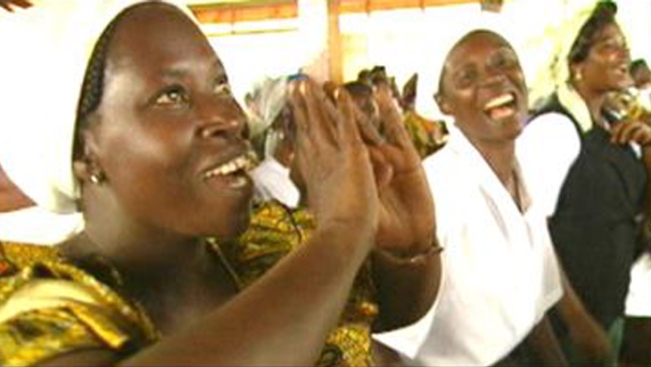 African Christianity Rising
African Christianity Rising
African Christianity Rising: Stories from Ghana is a documentary film by James Ault. This review of the film and reflections on it is by Prof Kirsteen Kim, Leeds Trinity University
I welcome this documentary and congratulate the film-maker and his team. It is perceptive, subtle and carefully made. And it is clearly the result of a real partnership between the film-maker from the USA and Ghanaian leaders. I would like to make some remarks about the film’s characteristics and the issues raised, and also raise a few further questions.
Characteristics
This first part of African Christianity Rising gives a refreshing perspective on African Christianity for several reasons. First, it is African and inclusive. The commentary is almost all by Africans. Furthermore, instead of one person pushing a particular view it is plurivocal. We are informed by scholarly and theological commentaries from Ghana of Prof. Kwame Bediako, Founding director of the Akrofi-Christaller Institute for Theology, Mission, and Culture in Akrapong, Catholic archbishop of Kumasi, Peter Kwesi Sarpong, and leading Pentecostal pastor, Dr Mensa Otabil. Apart from on the main theme of the rise of an authentic African Christianity, the commentators do not necessarily agree with each other but there no attempt to reconcile them; rather we are privy to debates within Africa. Moreover, the voice of the film-maker does not intrude or impose a heavy metanarrative. It is rather suggestive, raising issues for to be further discussed in teaching and research.
The film is inclusive in other respects too: It is ecumenical in the sense that it includes Protestant churches – Reformed (Grace Presbyterian) and Independent (Calvary Hill) – the Catholic cathedral in Kumasi, an African Independent Church (Mt Sion Revival Ministry) and a Pentecostal one (Christ Temple). It is also inter-religious in that it gives sympathetic attention to traditional healer (Mme Akitoa) and to the rituals at the court of the king. Traditional belief in ancestral spirits is rationalised rather than condemned as superstition. Another sign of the inclusive approach is around gender. Most interviews are with women – both church leaders and also members. The film gives a sense of the power of women and women’s groups in Ghana despite the male leadership in the mainline churches. (Nevertheless, I couldn’t help noticing that all the experts consulted were men.)
The second characteristic is that the documentary is intimate. The camera angles bring us in amongst the worshippers and on a level with them. The fact that the same individuals are followed over time (8 years) also helps to bring us close to them. The temptation of many documentaries on world Christianity is to focus on the big churches and the spectacular but this one begins with the small and the ordinary. The opening focus on Calvary Hill Chapel shows the nitty-gritty of church life and ministry. Another reason why the film is intimate is that it is interlaced with testimonies – Fred & Rose (Calvary Hill), Agnes and Aboathe (Grace Presbyterian plant), the disturbed girl at Mt Sion, the struggling seamstress, the people at the workers club. It is much like the pages of the New Testament – ordinary people caught up in the extraordinary.
Third, the film stresses African holism. If there is another theme beyond the vitality of African Christianity, it is the holistic nature of traditional African religion and culture. This is carefully brought out from Bediako’s initial comments at the beginning onwards. The cameras are not always trained on the churches. We learn about healing and deliverance and also about education, doing business, helping the workers, local development initiatives. To quote Otabil, through the churches, the people are receiving the ‘tools of life’. When we see what this means in the context of the grinding poverty of the seamstress, for instance, and the construction worker and others at the Calvary Hill workers’ group, it sheds a different light on the so-called ‘prosperity gospel’ that Africans are so often accused of preaching. Who in this situation would not pray and work for prosperity and well-being for their children, their congregation and for their nation? And does not the kingdom of heaven inspire hope of justice, peace and well-being? Why when Western-style development is lauded is African self-help is often dismissed or derided?
Issues raised
As well as demonstrating the African-ness of Christianity and the religion’s vitality in Africa, the film is valuable in that it addresses a number of key issues which often arise in the study of mission and world Christianity. First, the role of European missions. For a change we see the European missionary movement through African eyes rather than from the perspective of European historians. Although the Western missions are mentioned, the African perspective puts their role in perspective as merely catalysts of a Christian movement that has been driven by African agency. Although credit is given to the Moravian missionaries, some of whom were Africans from the Caribbean, the harmful effects of colonial missionary work are to the fore – negativity toward traditional cultures, criticisms of Africans that lowered their self-esteem, domination and paternalism. While all this is sadly true – and it is graphically evidenced in some of the old photographs, to me this sits rather uncomfortably with the obvious fact that the main critics are leaders of mission-founded churches.
A major interest of the film is the relationship between Christianity and African traditions, especially through the wise comments of Archbishop Sarpong, who has been pioneering Catholic inculturation. We are introduced to traditional healing practices, dances, music, symbols (like the white kerchiefs of victory) and attitudes. We hear about some of the difficulties of translating the message (e.g. the actions accompanying mea culpa) and about the importance of relating to traditional spirits and ancestors. Conversely, inculturation in Africa throws into relief the Roman or Western nature of the Christianity that was imported.
When we talk about this topic, we always have to consider with respect to which culture we are inculturating. In the film, as well as inculturation in the traditional culture, we also see – but with less comment – inculturation with respect to modern Africa: mobile phones, large modern buildings, business links, advertising and sponsorship of a Christian event by a bank, and the ubiquitous messages about success and blessing. In addition, we are made aware of some of the ongoing changes in culture, especially the shift from rural – represented by the older model of Mt Sion Revival Ministry – to urban. Even the traditional healer moves to city. Inculturation is an ongoing dynamic. For how long will the rural traditions convey meaning to urban Africans?
A third issue is deliverance and African theology. Deliverance ministry is shown to be widespread across the churches – although not shown in the Catholic Church. Each example of deliverance could profitably be analysed from a psychological point of view and in terms of the power relations between the healer, the healed and those encouraging them to go for healing. However, what strikes me in the film is the apparent contradiction between inculturation and deliverance. Deliverance appears to be from the very African spirits that the inculturationists are affirming. At the same time in the film ‘breakthrough’ signals Africans becoming truly Africans. Inculturation and deliverance raise key theological questions about how the gospel is authentically proclaimed in Africa. Through the film we see the emergence of African theology or African theologies. In this respect it is really helpful to have the words of the worship songs on the screen because these highlight key theological concepts – many inherited from Western sources but newly appropriated in African contexts.
Another key issue to mention is the African diaspora and so-called ‘reverse mission’: the growing phenomenon of missionary movements from the former mission-fields back to the West which is facilitated by globalisation and migration movements. Even without these intentional missions, African Christianity has already had a significant – and rarely recognised – impact on Western churches, especially their worship practices, through its music and rhythms. Near the end of the film we saw two examples of missions to the USA (the Grace Presbyterian evangelist and Mensa Otabil) as if mission is coming full circle. What is being exported is clearly an African gospel – but how could it be otherwise? What is more its African-ness is also its value. But what comes back is not always palatable in the West. African and Western differences to issues of sexuality – not raised in the film – have threatened the unity of the global Anglican Communion for instance. Will African missions engage existing traditions in their mission fields in more constructive ways than European ones did?
Questions
The film covers a lot of ground and is necessarily selective. We learn a great deal as it is but there are some further questions that it raises. First, what are ecumenical relations like between the churches? We are told that the deliverance ministry at Grace Presbyterian attracts people from other churches but is this a sign of competition between different churches for members? Second, I would like to know something more of the context of Ghana. For example, a local language Twi was mentioned but it seemed that the lay evangelist Aboathe did not speak it. Are the churches divided by language? The scene of pastor Fred leading prayers before the local king was fascinating. How typical is this kind of Christian involvement with society? Another question about the context is whether Ghana was chosen for this documentary because it is in some way representative of sub-Saharan Africa, or for other reasons? Third, Islam was not mentioned. In view of the news from other West African countries of clashes between the two religions, what are Christian-Muslim relations like in Ghana? And are theologians as enthusiastic about inculturation with respect to Islam? Finally, it was appropriate that the focus was on African churches but I would also like to know about contemporary foreign missions. What kind of Western, Korean and other Christian missions are in Ghana and how do these relate to the various African churches and wider society?
